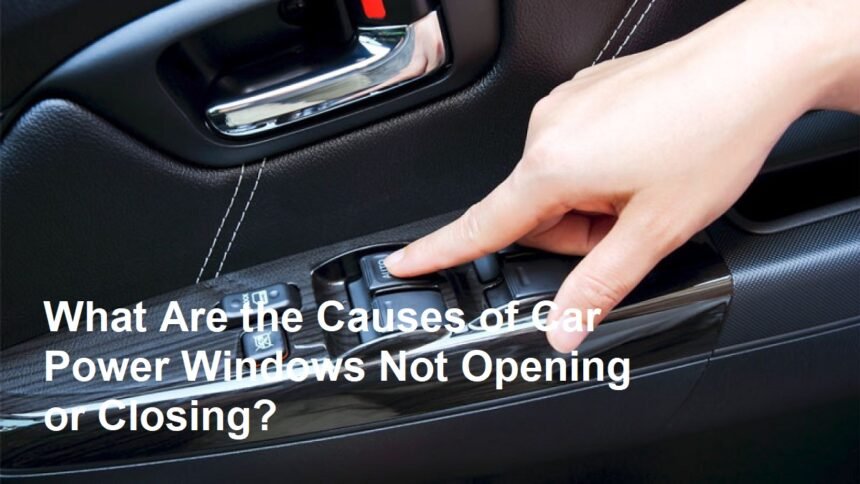Introduction
Power windows are one of the most convenient features in modern vehicles, allowing drivers and passengers to effortlessly open or close windows with just a push of a button. However, like any electronic component, power windows can sometimes malfunction, causing inconvenience or even security issues. If your vehicle’s power windows refuse to open or close, it’s essential to understand the potential causes to diagnose and repair the problem effectively.
Common Causes of Power Windows Malfunctioning
1. Blown Fuses
One of the most straightforward reasons for power windows to stop functioning is a blown fuse. Electric circuits are protected by fuses that prevent overloads or short circuits. When a fuse blows, it breaks the circuit, disabling the power window system. The fuse responsible for the power windows is usually located in the vehicle’s fuse box, which can be found under the dashboard or in the engine compartment. Checking and replacing a blown fuse often resolves the issue quickly.
2. Faulty Window Switch
The switch that controls the power windows can become faulty over time due to wear, dirt, moisture, or corrosion. A defective switch might not send the electrical signal to the window motor, rendering the window inoperative. If other windows or control buttons work fine, but a specific window won’t move, the switch is likely the problem. Testing the switch with a multimeter or swapping it with a known working switch can confirm this.
3. Bad Window Motor
Each power window is operated by an electric motor. When the motor fails or burns out, the window will remain stuck in its position. Signs of a faulty motor include hearing a faint humming sound when pressing the window switch, but the window does not move. Replacing a faulty motor is usually straightforward but may require removing the door panel.
4. Broken or Jammed Window Regulator or Tracks
The window regulator is a mechanical component that raises or lowers the glass, directed along tracks inside the door. If the regulator breaks, slips, or if the window tracks are bent or clogged with debris, the window may become immobilized. Rust, corrosion, or accumulations of dirt can cause the regulator or tracks to jam, making it impossible for the window to move. Repairing or replacing the regulator and cleaning the tracks can restore proper function.
5. Electrical Wiring Issues
Electrical problems such as damaged wires, loose connections, or corrosion at connector points can interrupt power to the window motor. Over time, vibrations or exposure to moisture can cause the wiring harnesses to wear out or get damaged. Inspecting wiring and connections with a multimeter can help identify broken or corroded wires that need repair.
6. Battery or Power Supply Problems
Since power windows rely on the vehicle’s electrical system, a weak or failing battery can limit the voltage supply, preventing windows from functioning properly. Similarly, issues with the alternator or wiring that supplies power to the system can cause power fluctuations or interruptions. Ensuring the battery is healthy and the alternator is charging correctly is crucial.
7. Lock or Safety Features
Many vehicles have a window lock feature that prevents passengers from operating their windows, often for safety reasons. If the lock switch is engaged, it disables window controls on other doors. Checking whether this lock is active can quickly explain why a window refuses to open or close.
How to Diagnose and Fix Power Window Issues
To troubleshoot, start with the simplest solutions: check the fuse and ensure it is intact, test the window switch, and listen for sounds from the motor when pressing the button. If no sound is heard, the motor might be faulty, or there could be electrical wiring issues. Inspect the wiring harnesses and connections for damage or corrosion. If these basic steps don’t resolve the problem, removing the door panel to examine the regulator, tracks, and motor might be necessary.
When to Seek Professional Help
If you are unfamiliar with auto repairs or feel uncomfortable performing diagnostics, it’s wise to consult a professional mechanic. A trained technician can quickly identify the root cause and perform necessary repairs, ensuring your power windows operate smoothly again.
Conclusion
Power window failures can stem from various causes, including electrical, mechanical, or control system issues. Regular maintenance, such as checking fuses, inspecting wiring, and keeping tracks clean, can prevent many problems. When issues arise, prompt diagnosis and repair will ensure your vehicle’s convenience and safety are maintained.












